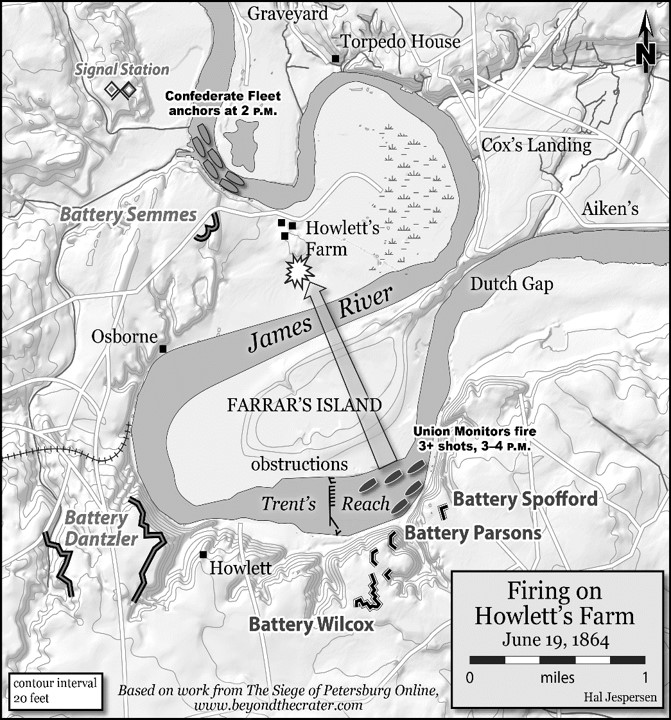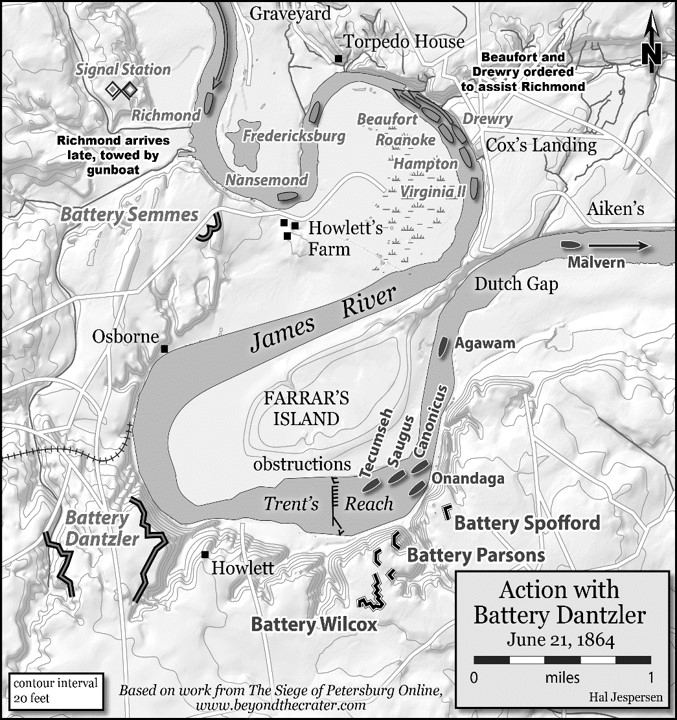Emerging Civil War welcomes guest author John Horn.
On June 21, 1864, the Confederates had an unpleasant surprise planned for the ships of the Federal fleet on Trent’s Reach and Varina Reach of the James River, below where the Northerners had sunk obstructions on June 15.
Preparations for a Southern operation began after an incident on June 19, when the three ironclads of the James River Squadron—CSS Virginia II, CSS Richmond, and CSS Fredericksburg—and three wooden gunboats dropped down the James from their moorage at Chaffin’s Bluff. They anchored at 2:00 p.m. in the shelter of Howlett’s Bluff, on the right bank of the James above Howlett’s farm, which lay above Farrar’s Island. Their sailors could see the top of the Union army-navy signal tower at Trent’s Reach, and their ships were visible from the tower, but the Confederate tars could not see the Northern monitors that had entered Trent’s Reach. Scarcity of ammunition prevented the Southerners from trying to destroy the tower.
The Union monitors opened on the secessionist ironclads, employing indirect fire with the assistance of spotters atop the signal tower. A shell fired from one of the monitors “exploded just at the river bank and scattered the pieces about the forward deck of the Virginia, wounding three men,” recalled Richmond’s commander, Lt. William Harwar Parker. “While we were wondering at this, another shell came and exploded just after it had passed over us, and again another.”
Unable to return the fire, the Rebel rams weighed anchor and returned to Chaffin’s Bluff. “The authorities in Richmond now became very anxious that the navy should make some demonstration on the river in order to relieve the great pressure on the army,” Parker remembered.[1]
 On the morning of June 20, Maj. Gen. George Edward Pickett, commander of the Bermuda Hundred lines, and Capt. John Kirkwood Mitchell, in charge of the James River Squadron, agreed on the specifics of a combined army-navy operation. Brigadier General George Washington Custis Lee would that afternoon with his Department of Richmond brigade of Local Defense Troops, 1,450 strong but mainly government clerks and laborers, drive in any Union pickets on the James’s north bank between Aiken’s and Dutch Gap and on Farrar’s Island. This would allow the ironclads and gunboats under Mitchell’s command to drop down the river at night and anchor between Cox’s Ferry and Cox’s Landing just above Dutch Gap without being observed. That evening, Col. Thomas Henry Carter would plant his two battalions of Army of Northern Virginia field batteries in pits on the elevated slope between Aiken’s and Cox’s Landing, near the Signal Tower.
On the morning of June 20, Maj. Gen. George Edward Pickett, commander of the Bermuda Hundred lines, and Capt. John Kirkwood Mitchell, in charge of the James River Squadron, agreed on the specifics of a combined army-navy operation. Brigadier General George Washington Custis Lee would that afternoon with his Department of Richmond brigade of Local Defense Troops, 1,450 strong but mainly government clerks and laborers, drive in any Union pickets on the James’s north bank between Aiken’s and Dutch Gap and on Farrar’s Island. This would allow the ironclads and gunboats under Mitchell’s command to drop down the river at night and anchor between Cox’s Ferry and Cox’s Landing just above Dutch Gap without being observed. That evening, Col. Thomas Henry Carter would plant his two battalions of Army of Northern Virginia field batteries in pits on the elevated slope between Aiken’s and Cox’s Landing, near the Signal Tower.
The Confederates intended to unmask four heavy guns at Battery Dantzler on Howlett’s Bluff, at the north end of the Bermuda Hundred line. They aimed to surprise and destroy the Federal ships on station in Trent’s and Varina reaches. The battery lay behind a screen of trees, which soldiers would cut down on the night of June 20, leaving the guns covered with brush.
Battery Dantzler would open fire at noon on June 21. Its guns would focus on the Union vessels in Trent’s Reach. The ironclads and gunboats under Mitchell’s command above Dutch Gap would begin shooting indirectly over the intervening trees at the Federal vessels in Trent’s and Varina reaches when Battery Dantzler opened. A signal officer from each Southern vessel would position himself to direct this fire. Carter’s field batteries would fire upon the Unionist wooden vessels below Aiken’s in Varina Reach.
Some segments of the plan went smoothly. The Confederate infantry and field artillery moved in stifling heat and dust from Chaffin’s Bluff to New Market Heights. There Custis Lee established his headquarters at the Drill Room, an assembly point for local guards at the junction of New Market and Turner roads. Despite losing many stragglers, he put his soldiers to work throwing up earthworks four miles long to connect Chaffin’s Bluff with New Market Heights.
Other elements of the plan encountered problems. On June 20, a Union army lookout observed the Rebel ironclads taking on sand in bags. His report alerted the Federal navy that the secessionists were preparing for action. As the Confederate ironclads got underway, Richmond parted her wheel-chain, which fouled her rudder, disabling her. Virginia II anchored below Cox’s Landing, Fredericksburg at Cox’s Ferry, and the secessionist wooden gunboats took station nearby.
 Trent's Reach Battery Dantzler (I-net Archive)
Trent's Reach Battery Dantzler (I-net Archive)
Not Battery Dantzler, but the monitor USS Tecumseh opened the fight at about 10:30 a.m. on June 21, after discovering that the Confederates had during the night felled the trees north of the Howlett barn, exposing the new line of works there covered with brush. Tecumseh fired from below the obstructions in Trent’s Reach, at a range of approximately 2,000 yards. The Southerners did not remove the brush and unmask Battery Dantzler until around 11:30 a.m., when monitors USS Saugus and USS Canonicus entered the fray at the summons of Tecumseh’s commander. Only at noon did Battery Dantzler’s four guns begin shooting. Then, remembered Acting Ensign John W. Grattan on the Federal flagship USS Malvern behind the monitors, “four white puffs of smoke were seen and the whistling and screaming of heavy solid shot told us the engagement had commenced.”[2]
Not until about 12:30 p.m. did the secessionist ships and Carter’s field artillery open fire. “Shot & shell fell within a few feet of our vessel and bursted over our heads,” recorded Grattan, who knew that a single well-aimed shot would annihilate the wooden Malvern.[3] The double-turreted monitor USS Onondaga engaged Battery Dantzler around 12:45 p.m., when the wooden gunboat USS Agawam also joined the fight and split the fire from her 9-inch smoothbores and 100-pound (6.4-inch) Parrott rifles between Battery Dantzler and the Confederate vessels, aiming her forward guns at the former and her aft guns at the latter.
Agawam, after hitting neither Battery Dantzler nor the Southern ships, ceased fire about 2:30 p.m. Aboard Malvern, Grattan noted, “3.15 a shell from the rebel iron clad struck within ten feet of the ship and threw mud over our deck in great quantity.”
 The monitors bombarded Battery Dantzler until late in the afternoon, dismounting a gun with Tecumseh’s last shot. Tecumseh “sent five XV-inch shell in rapid succession into the battery, and destroyed a platform, throwing the earth and timber in every direction,” recalled Grattan. Battery Dantzler and the secessionist vessels were still firing at 6:00 p.m. “The fight still continues nearly 100 shot & shell have been fired nearly a dozen have fell within 20 yards of the ship,” recorded Grattan aboard Malvern. “One burst right ahead and threw some fragments on deck.”[4] The Rebel missiles from the battery and the Confederate ships drove Agawam—the sole Union wooden vessel in Trent’s Reach—below Aiken’s, where Agawam with Malvern took ineffective fire from Carter’s field batteries and Custis Lee’s field guns on New Market Heights. The Confederate batteries and ships kept shooting until sunset.
The monitors bombarded Battery Dantzler until late in the afternoon, dismounting a gun with Tecumseh’s last shot. Tecumseh “sent five XV-inch shell in rapid succession into the battery, and destroyed a platform, throwing the earth and timber in every direction,” recalled Grattan. Battery Dantzler and the secessionist vessels were still firing at 6:00 p.m. “The fight still continues nearly 100 shot & shell have been fired nearly a dozen have fell within 20 yards of the ship,” recorded Grattan aboard Malvern. “One burst right ahead and threw some fragments on deck.”[4] The Rebel missiles from the battery and the Confederate ships drove Agawam—the sole Union wooden vessel in Trent’s Reach—below Aiken’s, where Agawam with Malvern took ineffective fire from Carter’s field batteries and Custis Lee’s field guns on New Market Heights. The Confederate batteries and ships kept shooting until sunset.
The affair caused little damage. A ten-inch Columbiad in Battery Dantzler inflicted minor damage on the deck of Saugus, while an eight-inch rifle slightly damaged Canonicus’ deck. Battery Dantzler required re-masking that night and remained out of action several days because of the damage caused by Tecumseh.
“The whole affair…was a fiasco,” remembered Parker. The Confederate guns could not hurt the monitors at long range, the ironclads could not stand up to the 15-inch Dahlgrens of the monitors at short range, and the only hope of sinking the monitors lay in a suicidal dash by wooden gunboats armed with spar torpedoes through the obstructions in Trent’s Reach under the fire of Federal land batteries. “The fact is we were wrong in yielding to the clamor of the army to ‘do something,'” Parker recalled.[5]
Parker proved too pessimistic. Battery Dantzler largely drove the United States Navy out of Trent’s Reach. Wooden vessels could not remain there under the crossfire of the battery at the upper end of the reach and the Confederate ironclads dropping down from Chaffin’s Bluff to Dutch Gap at the upper end of Farrar’s Island. The Union monitors could not maintain a protracted fire on the battery because of the short life of their guns, the endurance of their men, and their supplies of ammunition and fuel. Stalemate prevailed for the remainder of the war, despite an unsuccessful Confederate attempt to later run the obstructions and attack City Point in January 1865.
Born and reared in Chicago, John Horn has practiced law there since 1976. He has written three books and co-edited another about Petersburg, Virginia’s soldiers, and the siege of that city. His most recent book, The Petersburg Regiment in the Civil War: A History of the 12th Virginia Infantry from John Brown’s Hanging to Appomattox, 1859-1861 (Savas Beatie), won the 2019 Army Historical Foundation Distinguished Writing Award for Unit History. The book he is working on now is Grant Lays Siege to Lee: Petersburg, June 18-July 1, 1864. He has published articles in Civil War Times Illustrated, America’s Civil War, Gettysburg Magazine, North & South Magazine and civilwartalk.com. He has blogged at johnhorncivilwarauthor.blogspot.com since 2015.
Endnotes
[1]Ibid., 108-109; John W. Grattan Diary, June 21, 1864, John W. Grattan Papers, Library of Congress.
[2]Parker, Recollections of a Naval Officer, 338.
[3]Robert J. Schneller, Jr., ed., Under the Blue Pennant, or Notes of a Naval Officer 1863-1865, by John W. Grattan, Acting Ensign, United States Navy (New York, 1999), 108.
[4]Ibid., 109.
[5]William Harwar Parker, Recollections of a Naval Officer (New York, 1883), 337.
No comments:
Post a Comment